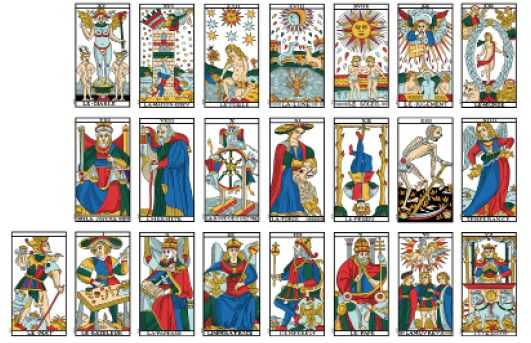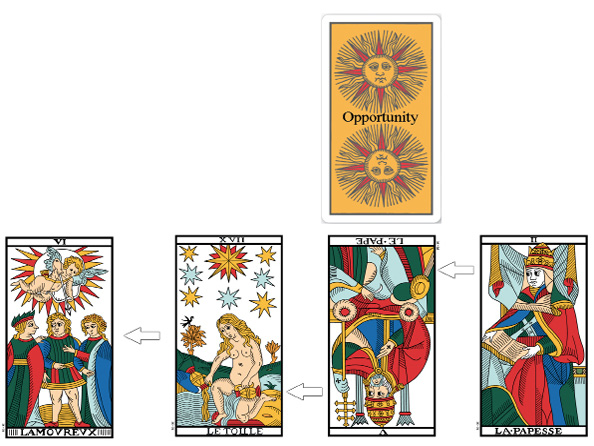A second and fundamental rule which disciplines the disposition of the cards, the Syntax, during a practical reading, is the Law of Opportunity ( or of Resolution ). In this case, as well we find an objective rule. In order to understand its mechanism, it is necessary first to consider one point: if we hypothesize the existence of a solution-principle, this must necessarily be tied to a problem-principle. To verify this idea, let us observe again the 3x7 Diagram:

Fig. 24
The 3x7 Diagram
Among all the cards, there is one whose position is completely different compared to the others: the Hanged Man. It is the only Arcanum in which the figure is physiologically reversed, that is, when the card is placed correctly as are the others, with the number above, the personage is actually upside down.
We have already mentioned this; but simple observation of the iconography is enough to see that the man, bound to a sort of gallows (which brings to mind hanging, as is suggested by the many Tarot decks that copy this idea), is in a condition of immobility and impotence, a problematic state. This allows us to suppose that, as in the Tarot all is codified, a card “normally” reversed, which symbolizes a problem, suggests that this position has a special significance related to the concept of difficulty. Therefore, in the course of the reading we must consider that a card extracted in a reverse position indicates a problem, an obstacle for that personage or that Archetype:
Reversed Position -- Problem Card
This position is objectively disciplined and reminds us that we must interpret the cards in both positions. To develop a reading with only right side up cards would be legitimate but incomplete, as extraction may occur in either direction. What, then, should be our action in the case of a reversed card? The answer, according to the Law of Contemplation , is simple and powerful. As in everyday life, in order to solve a problem, we must find a solution, thus in the Tarot we need to extract another card and place it above, “in the sky of”, the reversed one, to be able to resolve the problem. In the example, to allow the Hierophant to be right side up, restoring him to his natural condition, we must place a card above him, the Opportunity (or Resolution) Card :
The
Opportunity Card is placed above the Problem Card
.

Fig. 25
Opportunity Card
As the subject is of extreme interest, we will open a brief parenthesis.
As is known to the many lovers of the Tarot, the cards are principally used today for divination, predicting the future. Passing over the great general problems regarding this utilization, of which we will speak later, we wish to concentrate on one of the more evident difficulties relevant to this practice. To exemplify it, we will use an anecdote.
One day, during a course, one of the participants told of a consultation with a cartomancer of his city. The man narrated that, at the end of the reading, the woman, somewhat troubled, wrote a brief message on a scrap of paper and gave it to him sealed, telling him to read it only after he had arrived home. Taking his leave of the fortune-teller, the man departed, respecting her instructions. On his way home, however, he was involved in a traffic accident in which, although the drivers were not injured, the vehicles were badly damaged. Some days later, having gotten over the residual shock, he remembered the small note, which he found and read, finding, amazed, the following words: “ Imminent danger with the auto ”. What had happened? The woman had foreseen the event without being able to intervene in order to avoid it. What does this teach us?
The tale emphasizes one of the greatest limits that have always characterized cartomancy: the impossibility to offer solutions to problems that may arise during a reading. It is not unusual to hear stories of individuals who, approaching a study of the Tarot, have become quite frightened. Why? Usually the triggering factor consists in having found themselves facing a negative situation before which they feel such a sense of impotence and inevitability, to find themselves at the point at which they decide never again to use the Arcana. This behaviour is not to be blamed, on the contrary. How may we use an instrument which leaves us so passive and incapable of answering in the face of certain events? What sense is there in being able to predict them? Fortunately, it is not thus; as, knowing the true essence of the Tarot, we discover that it offers solutions that the consultant may apply (in accordance with his own free will), avoiding that attitude of inevitability and resignation typical of a fatalistic point of view. In the case of our tale, if the cartomancer had known the Law of Opportunity , facing the danger of an accident she would have been able to suggest the manner, indicated by the Tarot, to avoid the danger.
This circumstance would have given inestimable value to the consultation. We wish to emphasize our own point of view with this last, obvious, reflection, hoping that no extremistic thinker will raise his voice, opposing divination in all its forms, preferring bad luck to good. In another chapter we will examine this subject again more vastly and in detail. In any case, we wish to emphasize up front that the Tarot, as much as any other instrument of aid and support, is able to give precious help, equal to that offered by modern Science. The great difference is that, in the case of the Icons, the counsel received originates from a marvellous extra-ordinary Intelligence of infinite capacities! In our opinion, then, one of the enormous advantages deriving from the discovery of the Coded Structure is precisely the individuation of this Law of Opportunity whose application RADICALLY changes the approach to the reading, even to the “forecasted” one.